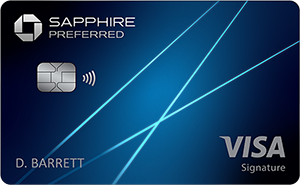Chase Sapphire Preferred vs. Chase Sapphire Reserve Card: 2 Powerhouse Travel Cards Compared

The Chase Sapphire Reserve® and Chase Sapphire Preferred® Card are two of the best travel credit cards on the market today. But although they both have Sapphire in their names, the $95-annual-fee Sapphire Preferred Card is better for budget-minded travelers who don’t need premium perks like airport lounge access.
The Sapphire Reserve slides into that spot with an annual fee of $795, but comes with over $2,700 in annual travel value and includes access to Priority Pass and Chase Sapphire Lounges.
Which Sapphire card is right for you? Let’s break down how the Sapphire Preferred Card and Sapphire Reserve compare.
How the Cards Compare: Chase Sapphire Preferred Card vs. Sapphire Reserve
Side By Side Comparison
Annual Fee
Purchase and Balance Transfer APR
Welcome Bonus
Ongoing Rewards
Pros & Cons
- Luxury Perks
- 1:1 Transfer Partners
- Premium Travel Protections
PROS
- High annual fee
- No intro APR for purchases or balance transfers
- Might not make sense for people who aren’t frequent travelers
CONS
- Generous intro bonus
- Primary rental car coverage
- 10% Anniversary Bonus
PROS
- Lounge access or free checked bags are not available
- No intro APR for purchases or balance transfers
- Complicated rewards
CONS
Learn More
Welcome Bonuses
The bonuses on the two cards are often similar, although that can change at any time thanks to limited-time offers and promotions. For example, the Chase Sapphire Preferred Card in early 2025 offered its highest-ever bonus of 100,000 Ultimate Rewards points, but only for a limited time.
If you’re torn between the two cards based on the bonus alone, it can make sense to choose the one with the highest bonus.
Chase Sapphire Preferred Welcome Bonus
The Sapphire Preferred Card offers 75,000 points after spending $5,000 on purchases within the first three months of opening the account. That spending requirement may seem intimidating, but it breaks down to just $1,667 a month in spending. Put everything you can on the card, like groceries, gas and utilities, and that number might become more feasible.
Chase Sapphire Reserve Welcome Bonus
The Chase Sapphire Reserve is offering a massive bonus. New cardholders can earn 125,000 points after spending $6,000 on purchases within the first three months from account opening.
Although you won’t typically get your new physical card in the mail for several days, Chase allows you to instantly add your new Sapphire card to your wallet after your approval, which can help you jump-start your spending.
CardCritics™ Opinion
The Sapphire Reserve comes out ahead with its unprecedented welcome offer, but the Sapphire Preferred Card’s bonus is still a great option for those who don’t want to pay a high annual fee.
Earning Rewards
Both the Sapphire Preferred Card and the Sapphire Reserve earn elevated rewards on travel and dining, but the Reserve’s reward rates are higher in some cases, as befits a premium card with a premium fee.
How To Earn Rewards With Chase Sapphire Preferred
The Sapphire Preferred Card earns strong rewards on travel, especially when booked through Chase Travel, and also earns compelling rewards on dining, which includes takeout and eligible delivery services:
- 5x points on Chase Travel℠ bookings (excluding purchases that qualify for the card’s $50 annual hotel credit)
- 3x points on dining, including restaurants, takeout and eligible delivery services
- 3x points on online grocery purchases
- 3x points on select streaming services
- 2x points on all other travel purchases
- 1x points on all other purchases
How To Earn Rewards With Chase Sapphire Reserve
The Sapphire Reserve also earns strong rewards on travel and dining, and the highest rates are reserved for Chase Travel and direct airline and hotel bookings. However, it doesn’t offer an elevated rate on other travel:
- 8x points on all purchases through Chase Travel
- 5x points on Lyft purchases (through Sept. 30, 2027)
- 4x points on flights and hotels booked directly
- 3x points on dining
- 1x points on all other purchases
CardCritics™ Opinion
The Chase Sapphire Reserve offers better rewards in specific travel categories, but the Sapphire Preferred Card includes some everyday expenses that could tip the scales in its favor, depending on your personal spending patterns.
Redeeming Rewards
Both cards earn valuable Chase Ultimate Rewards® points, which you can redeem for travel, cash back, gift cards and merchandise. You’ll get a higher value on some Chase Travel redemptions through Chase’s new Points Boost feature, but at different rates.
You’ll typically get the most value from these cards by transferring your rewards to Chase’s airline and hotel partners, such as United MileagePlus and World of Hyatt.
How To Redeem Rewards With Chase Sapphire Preferred
Ultimate Rewards points earned on the Sapphire Preferred Card are flexible and can be redeemed in multiple ways:
- Purchase travel through Chase: With this option, your points are worth 1 cent each. However, on Points Boost flights and hotels, they’re worth 1.5 cents each, and on select premium-cabin flights, they’re worth 1.75 cents apiece.
- Transfer to travel partners: Chase has over a dozen travel loyalty partners you can transfer your Ultimate Rewards to at a 1:1 ratio. These include JetBlue TrueBlue, Southwest Rapid Rewards, United MileagePlus, Marriott Bonvoy, IHG One Rewards and World of Hyatt.
- Statement credit/cash back: Rewards redeemed as cash back to an eligible bank account or as a statement credit are worth 1 cent per point.
- Gift cards: Points can be used to buy gift cards through Chase, typically at a value of 1 cent per point, although occasionally, certain gift cards will be on sale.
- Merchandise: You can use points at checkout with Apple, PayPal and Amazon (rates vary).
How To Redeem Rewards With Chase Sapphire Reserve
You can redeem points earned with the Sapphire Reserve in the same way as the Sapphire Preferred Card, except points can be worth even more when used for travel through Chase Travel. With Points Boost, you’ll get a value of up to 2 cents per point when you redeem for select flights and hotels, and for bookings through The Edit℠, Chase’s luxury hotel booking program.
CardCritics™ Opinion
Both cards have nearly identical redemption options, except for when you redeem through Chase Travel. Sapphire Reserve cardholders can get a better value when booking through Chase Travel (up to 2x through Points Boost) while Sapphire Preferred cardholders receive up to 1.75x.
Card Benefits
Both cards carry a range of purchase and travel protections — and Chase Sapphire travel coverage is arguably some of the best of any travel insurance credit card on the market. You might not think these extras should factor into deciding what credit card to get, but if something goes wrong on a trip, you’ll be grateful to have these benefits.
Chase Sapphire Preferred Benefits
For a card with an annual fee of just $95, the Sapphire Preferred Card packs a lot of perks. Notable benefits include:
- Up to $50 in statement credits each account anniversary year for hotel stays purchased through Chase Travel
- Complimentary DashPass, a delivery subscription worth up to $120 (activate by Dec. 31, 2027)
- Primary car rental insurance
- Trip cancellation and interruption insurance, baggage delay insurance, trip delay reimbursement, purchase protection and extended warranty coverage
- Points bonus equal to 10% of total annual card spending each card anniversary
Chase Sapphire Reserve Benefits
For its heftier $795 annual fee, the Sapphire Reserve’s benefits are even more robust (enrollment required for some perks) and include:
- Annual travel credit of up to $300
- Up to $120 credit every four years toward the Global Entry, TSA PreCheck or NEXUS application fee
- Up to $500 in annual credit for The Edit
- Up to $300 in annual dining credit with Chase Sapphire Exclusive Tables
- Up to $300 in annual StubHub and Viagogo credit
- $250 in annual value with Apple TV+ and Apple Music
- Up to $120 annual credit toward Peloton Membership
- Up to $120 in annual Lyft in-app credits
- IHG One Rewards Platinum Elite status (activation required)
- Priority Pass and Chase Sapphire Lounge access
- DoorDash and DashPass benefits
- Trip cancellation and interruption insurance, baggage delay insurance, trip delay reimbursement, purchase protection and extended warranty coverage
- Plus, emergency evacuation and transportation coverage up to $100,000, travel accident insurance up to $1,000,000 in accidental death or dismemberment coverage, and emergency medical and dental
- Extra benefits for big spenders who make $75,000 or more in purchases per year
CardCritics™ Opinion
The benefits on the Sapphire Preferred Card are unrivaled among mid-tier travel cards, but the perks are even better on the Sapphire Reserve if you’re willing to pay the much higher annual fee.
Fees and Costs
The most notable difference between the two cards comes down to the annual fees. The Chase Sapphire Preferred Card has a $95 annual fee, but, if you use the annual $50 hotel credit on the card, it will effectively cost you $45 a year. Similarly, the Sapphire Reserve’s multitude of credits can more than justify its $795 yearly cost.
Neither of these cards adds foreign transaction fees, making them two of the top credit cards for international travel.
Chase Sapphire Preferred Fees and Costs
Here’s what to expect on the Sapphire Preferred Card.
- APR: 19.99% - 28.24% Variable
- Foreign transaction fee: None
- Authorized user fee: None
- Balance transfers: Either $5 or 5% of each transfer, whichever is greater
- Cash advances: Either $10 or 5% of the amount of each transfer, whichever is greater
- Returned payment: Up to $40
- Late payment: Up to $40
Chase Sapphire Reserve Fees and Costs
The annual fee on the Chase Sapphire Reserve can be hard to swallow, but if you’ll make use of the card’s many benefits, it can be worth it.
- APR: 20.24% - 28.74% Variable
- Foreign transaction fee: None
- Authorized user fee: $195 per card per year
- Balance transfers: $5 or 5% of the amount of each transfer, whichever is greater
- Cash advances: Either $10 or 5% of the amount of each transfer, whichever is greater
- Returned payment: Up to $40
- Late payment: Up to $40
CardCritics™ Opinion
Again, the biggest difference here is annual fees. Ultimately, it comes to your goals with a new credit card and if you’re willing to pay a premium price for the Sapphire Reserve’s additional benefits.
How To Choose Between Chase Sapphire Preferred vs. Chase Sapphire Reserve Card
Both cards are tops when it comes to choosing a travel credit card due to their earning rates, lack of foreign transaction fees and long list of benefits and perks any traveler can appreciate. Your individual travel needs and spending habits will dictate which one of the two is the best choice for you.
If you don’t want to shell out a hefty annual fee for a credit card, the Chase Sapphire Preferred Card still has plenty to offer. But if upscale benefits like airport lounge access, partner statement credits and additional travel coverage sound like features you want, the Chase Sapphire Reserve is the better choice.
The information related to the Chase Sapphire Reserve® was collected by CardCritics™ and has not been reviewed or provided by the issuer of this product/card. Product details may vary. Please see issuer website for current information. CardCritics™ does not receive a commission for this product.
Frequently Asked Questions About the Chase Sapphire Preferred vs. Reserve
What are the application rules for the Chase Sapphire Preferred and Reserve?
Chase recently updated the application rules for its Sapphire cards. With either card, you won’t be approved if you already have that specific card open. And you may not qualify for a welcome bonus if you previously received a bonus for the card, or if you currently have a different Sapphire card open.
Plus, an unwritten policy, referred to as the Chase 5/24 rule, means you won’t be approved for most Chase credit cards if you’ve opened five or more cards (from any bank, except certain small-business cards) in the past 24 months.
Can you upgrade from Chase Sapphire Preferred Card to Sapphire Reserve?
If your Sapphire Preferred Card has been open for at least 12 months, you may be able to upgrade to a Sapphire Reserve credit card. Call Chase for more information.
Which Sapphire card offers better value for redemptions?
Both the Sapphire Preferred Card and the Sapphire Reserve earn elevated rewards on travel and dining, but the Reserve’s reward rates are higher in some cases.
Does the Chase Sapphire card have lounge access?
The Chase Sapphire Reserve comes with Priority Pass and Sapphire airport lounge access with enrollment. The Sapphire Preferred Card does not have lounge access.
What credit score do you need for a Chase Sapphire card?
As rewards credit cards, the Sapphire Preferred Card and Sapphire Reserve require credit scores in the higher range. The Sapphire Preferred Card is geared to consumers with at least a good credit score (a score of 670 or higher on FICO’s scale). Meanwhile, the Sapphire Reserve requires an excellent score to be considered.
Keep in mind that there is no specific score that will guarantee approval for a card. Issuers look at a range of factors, including your overall financial standing.














